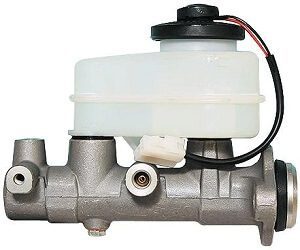Brake Master Cylinder Replacement Cost
Last Updated on December 29, 2023
Written by CPA Alec Pow | Content Reviewed by ![]() CFA Alexander Popinker
CFA Alexander Popinker
The role of the brake master cylinder is to transform the mechanical pressure applied on the brake pedal into hydraulic pressure. Hydraulic pressure is required for the brake calipers to tighten the brake pads and therefore to slow down the car. When using the car and as in the case of other parts, the brake master cylinder may be damaged.
How much does the replacement of the brake master cylinder cost?
The amount of money you are going to spend in order to replace the brake master cylinder will be influenced by the dealer/mechanic you choose to go to and make and model of your car. According to our online research, the average costs with the parts and the mechanic will be anywhere between $260 and $650. Expect to pay around $360 to replace the cylinder brake at an average car, while for a luxury brand such as Mercedes-Benz or BMW you will have to pay around $630.
Depending on the make and model of the vehicle, be prepared to spend only for the parts anywhere between $50 and $300. Taking into consideration that this job would take an average mechanic almost two hours to complete, you should add another $220 to the costs to get closer to the total sum.
According to the Your Mechanic website, the average costs charged by a dealer to replace the brake master cylinder would be anywhere between $180 and $450.
In the table below you will find the average costs for replacing the brake master cylinder for different types of cars.
| Make/Model | Average Price |
|---|---|
| Ford Explorer | $255-$500 |
| Chevrolet Silverado 1500 | $290-$490 |
| Ford Focus | $260-$560 |
| Ford F-150 | $285-$520 |
| Honda Accord | $330-$465 |
| Ford Fusion | $320-$475 |
| Honda CR-V | $320-$475 |
| Honda Civic | $320-$395 |
| Toyota Corolla | $290-$520 |
| Toyota Camry | $275-$490 |
| Nissan Altima | $210-$500 |
What are the extra costs?
During the repair, it is possible to discover that other parts of the braking system like the tubes, calipers, or cylinders are damaged and must be replaced as well.
You might also like our articles about the cost of brake pad replacement, brake line repair, or brake bleeding services.
Brake master cylinder details
When you depress the brake pedal to stop the vehicle, its braking system uses a brake master cylinder to convert the pressure you put on the brake pedal into hydraulic pressure.
Pressure conversion occurs as the brake master cylinder transfers the brake fluid to the brake circuit as you depress the brake pedal. The brake master cylinder will do this regardless of whether the vehicle uses a drum or disc brake system. There is no braking system without a brake cylinder.
Where is the brake master cylinder located?
The good news is that you don’t have to go very far to find the brake master cylinder in your car. Once you have found the brake pads, you are in the right area. You will notice, however, that the size and number of pistons is usually larger in the front to be able to withstand the weight wave during the braking process.
Logically, the rear calipers will be smaller because the weight distribution on the back is lower during braking. When you press the pedal, the valve has the role of distributing like a divider when it comes to the weight balanced between the front and the rear. The brake master cylinders then transmit the pressure to the wheels.
But the conclusion remains that when difficulties arise or you notice something wrong with the braking system, you should definitely turn to a specialist and not start the repair process yourself without knowledge in the field. Put your safety and your car’s integrity first!
Brake master cylinder replacement overview
The first thing a mechanic will do before deciding if the brake master cylinder is damaged is to inspect and test the brake system and check if there are any leaks. In this situation, you will have to replace the entire part, which is placed beneath the car.
After establishing that the brake master cylinder is faulty, it will be disconnected from its connectors with a socket wrench and then removed. During this process, the brake fluid will be flushed and changed as well because it can get contaminated with the current brake fluid.
The next step is to clean the whole brake system with air and the parts surrounding it. After this, the new brake fluid will be injected into the lines and the brake master cylinder will be installed.
Finally, the mechanic will test if the car works properly.
Symptoms of a faulty master cylinder
Abnormal operation of the brake pedal
In order for the braking system to operate in normal parameters, the pressure generated by the brake master cylinder is required. When there are problems with sealing or pressure distribution, this will be felt in the pedal and braking mode of the car. A pedal that feels soft or sinks slowly on the floor when pressed should make any driver think. The most common cause of a soft pedal sensation is poor sealing. However, the presence of air in the brake lines can cause a similar symptom because the air bubbles prevent the fluid from flowing efficiently. Damage to the brake lines can cause a soft sensation when the brake pedal is depressed.
The brake pedal “sinks” when pressed
When a brake system is working properly, the brake pedal is going down properly when pressed. A defective brake master cylinder will cause the brake pedal to sink. Under normal conditions, when a brake pedal is depressed, it will return to its original position immediately. A pedal that “sinks” will remain close to the floor. Depending on the severity of the main cylinder damage, the brake pedal may return to its normal position but it will take some time. This symptom requires immediate attention!
Low level of the brake fluid
 Most of the brake fluid is in the main cylinder and in the brake lines. The brake master cylinder is positioned at the bottom of the tank containing the brake fluid. It is necessary to check for leaks at the proportional valves that connect to the separate brake circuits and at the control valve that transports the brake fluid from the tank to the main cylinder.
Most of the brake fluid is in the main cylinder and in the brake lines. The brake master cylinder is positioned at the bottom of the tank containing the brake fluid. It is necessary to check for leaks at the proportional valves that connect to the separate brake circuits and at the control valve that transports the brake fluid from the tank to the main cylinder.
Contaminated brake fluid
The brake master cylinder has rubber seals. Damaged rubber gaskets can break and brake fluid can be contaminated. When the rubber gaskets no longer seal properly, dirt, debris, and other particles may mix with the brake fluid. These contaminants affect the hydraulic pressure, causing the vehicle to stop harder.
The “brake” warning light comes on
Under the brake fluid reservoir is the sensor that communicates with the car’s onboard computer. If there is not enough brake fluid, the computer will turn on the brake warning light. Even if it is the first symptom of a faulty brake master cylinder, it is also not the only reason for the “brake” warning light to flash. Even the brake fluid level sensor may malfunction, causing the warning light to come on. If you notice that it is necessary to add brake fluid at smaller and smaller intervals, you should consider the existence of a problem with the brake master cylinder or a leak in the brake system.
Important things to consider
According to the Repair Pal website, the replacement of the brake master cylinder is a common repair for the majority of the vehicles and this should be done before the car reaches 125,000 miles.
You can prevent the failure of the brake master cylinder by sticking to a strict maintenance schedule and taking your car to a good mechanic whenever you spot a problem.


Leave a Reply
Want to join the discussion?Feel free to contribute!